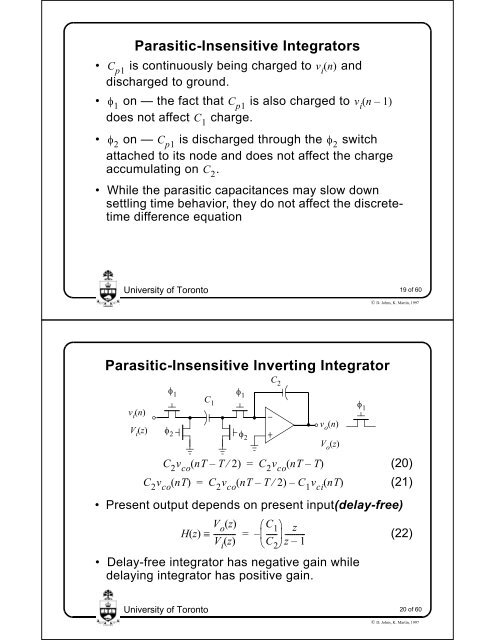Switched-Capacitor Circuits - University of Toronto
Switched-Capacitor Circuits - University of Toronto
Switched-Capacitor Circuits - University of Toronto
You also want an ePaper? Increase the reach of your titles
YUMPU automatically turns print PDFs into web optimized ePapers that Google loves.
Parasitic-Insensitive Integrators<br />
• Cp1 is continuously being charged to vi( n)<br />
and<br />
discharged to ground.<br />
• 1 on — the fact that Cp1 is also charged to vi( n – 1)<br />
does not affect charge.<br />
C 1<br />
• 2 on — Cp1 is discharged through the 2 switch<br />
attached to its node and does not affect the charge<br />
accumulating on .<br />
C 2<br />
• While the parasitic capacitances may slow down<br />
settling time behavior, they do not affect the discretetime<br />
difference equation<br />
<strong>University</strong> <strong>of</strong> <strong>Toronto</strong><br />
Parasitic-Insensitive Inverting Integrator<br />
vi( n)<br />
Vi() z<br />
1<br />
<strong>University</strong> <strong>of</strong> <strong>Toronto</strong><br />
C 1<br />
1<br />
2 2<br />
19 <strong>of</strong> 60<br />
© D. Johns, K. Martin, 1997<br />
• Present output depends on present input(delay-free)<br />
C 2<br />
vo( n)<br />
Vo() z<br />
C2vco( nT – T 2)<br />
= C2vco( nT – T)<br />
C2vco( nT)<br />
= C2vco( nT – T 2)<br />
– C1vci( nT)<br />
Hz ()<br />
• Delay-free integrator has negative gain while<br />
delaying integrator has positive gain.<br />
Vo z () C1 z<br />
----------- =<br />
– ----- ----------<br />
Vi() z C2z– 1<br />
1<br />
(20)<br />
(21)<br />
(22)<br />
20 <strong>of</strong> 60<br />
© D. Johns, K. Martin, 1997














